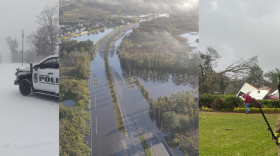Roseate spoonbills and other wading birds are digging Florida Audubon’s efforts to remove invasive Carolina willows that have overtaken vital wet prairies inside the Corkscrew Swamp Sanctuary east of Naples.
“Our marsh and prairie restoration efforts are helping bring birds back to areas within the sanctuary that had been overtaken by Carolina willow,” Lisa Korte, director of the sanctuary, said Friday. “Nature’s response to our restoration process is rapid.”
Wet prairies are a vital part of the Everglades. The low-depressions fill with moving water, grasses thrive, and critters crawl and swim in the shallow marsh. That, in turn, brings wading birds and other creatures to enjoy the cool water and poke around for a meal.
The Carolina willow is among the plants and animals native to Florida that are expanding the definition of “invasive species.” The Department of Agriculture says flora and fauna is invasive if it is likely to cause harm to the environment, the economy, or human health. Earlier conventions of the term included “exotic,” indicating if the plant or animal is to qualify as invasive it had to come from another part of the world such as the Burmese python from Asia now eating its way through the Florida Everglades.
The willow clearly meets the expanded understanding of an invasive species for numerous reasons. The most visible of those is that the willow consumes so much water annually — the amount is counted not in gallons but in feet deep — it can drink a large wet prairie dry. Then the willow’s serrated, spear-shaped leaves, which sprout out from branches and criss-cross one another, deny animals access to what’s left.
That’s what has been happening in places in the Corkscrew Swamp. But now that Korte’s land managers have cleared 867 acres of willow-infested wet prairies inside the 13,500-acre sanctuary, the environment is returning to what it was before invasives slowly grew into place.
“In the past few days,” Korte said, “water levels within one of the 2021 restoration units have been just right for roseate spoonbills, snowy egrets, and many others to find a plentiful buffet.”
Most of Corkscrew Swamp is off-limits to the public, but a 2.5-mile-long boardwalk into the darkened forest, raised above the swampy waters, lets visitors stroll along it for hours. The thick canopy and temperature of the water keeps the air cooler by several degrees, Cameras, bottled water, and natural bug spray or recommended.
The Corkscrew Swamp Sanctuary, 375 Sanctuary Rd. in Naples, is open from 8 a.m. to 3 p.m. every day of the year, although the last visitors are admitted at 1 p.m. so there will be two hours available to stroll through the preserve.
Read more about the Carolina Willow at Corkscrew Swamp Sanctuary.
Environmental reporting for WGCU is funded in part by VoLo Foundation, a non-profit with a mission to accelerate change and global impact by supporting science-based climate solutions, enhancing education, and improving health.








